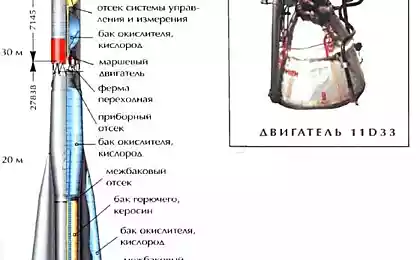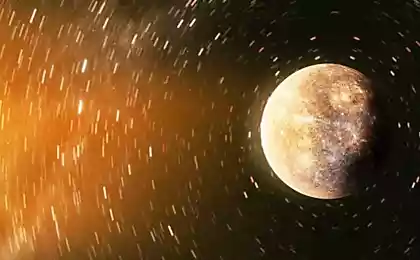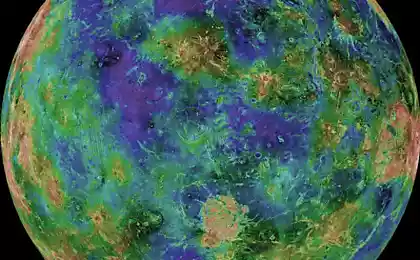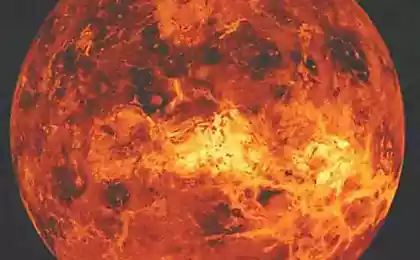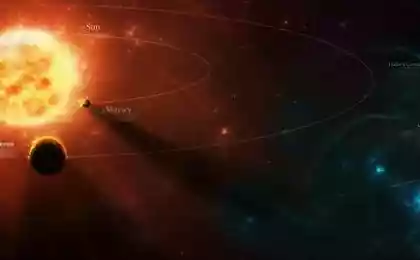618
The space of the home, part 4: how will we live on Venus
If so, how are we going to live on the moon and in space colonies, is quite clear — it remains only to Refine the technology, colonization of Mars and of other planets especially while covered with a veil of uncertainty. But any ideas on the topic of terraforming Venus, and life on it in the air cities we have. Let's discuss them.
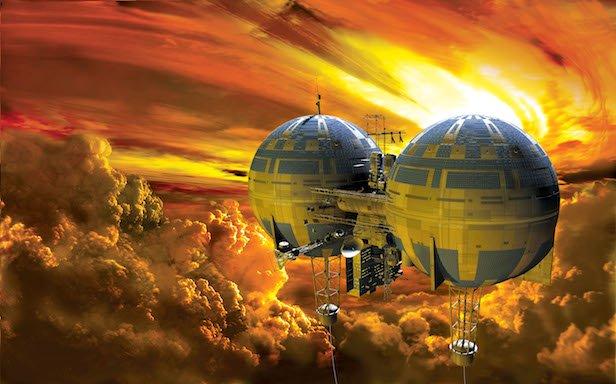
The artistic representation of the floating city on Venus
Study Venus
The first soft landing on Venus with the subsequent data transmission to Earth took place in December 1970. Apparatus "Venera-7" was launched from Baikonur on August 17, 1970, in 8 hours 38 minutes Moscow and a few months sat on Venus. And it was the first ever workable landing of a spacecraft on another planet.
As the name implies, it was not the first device. Before him, in 1961 the Soviet scientists launched the "Sputnik 7", which failed to exit from earth orbit. A few days Venus-1 went to the planet and passed at a distance of a hundred thousand miles away from her. A week after the station has stopped responding. Station "Venera-2" in 1965, flew a distance of twenty-four thousand kilometers from Venus, and Venera-3 reached their goal, but are unable to transmit data after landing. But it brought to Venus metal globe of the Earth with a pennant with the emblem of the Soviet Union.
Automatic research space station "Venera-7" was built taking into account a large number of not very successful launches. Previous spacecraft have helped scientists learn the conditions in which you will have to work. The new station had to withstand pressure six times greater than that of the two before her. Body reentry built from titanium to withstand pressures up to 180 atmospheres. For easing landing apparatus equipped with a grooved cone-shaped parachute of the four layers of stalonetray. As the energy carrier used a lead-zinc battery, charged by solar panels.
This device transmitted data to Earth for fifty-three minutes, twenty after landing. Thanks to the apparatus found that the surface temperature is 475 ±20 °C, pressure of 90 ±15 atmospheres. Before we received the first pictures from Mars, Soviet specialists got a picture with Venus. They made apparatuses "Venera-9 and Venera-10". Apparatus "Venera-13" made 14 color images of the planet.
In parallel with Soviet studies of Venus and was engaged in the United States. In 1962 to the "Morning star" launched "Mariner 1" but the booster rocket deviated from course and was blown up. In 1962 it was followed by "Mariner-2", the unit flew past Venus at a distance of 34 773 km. "Mariner-5" 1967 flew even closer, to 3 990 kilometers from the planet's surface. Cameras and cameras, unfortunately, none of the devices had, and all the other "Mariner" flying to Mars.

Photo, "Venus-9" and "Venera-10"

Photo, "Venus-13"
One of the programs on the study of Venus — the DAVINCI mission, which NASA plans for 2021. In the framework of the lander within 63 minutes to collect data about the planet's atmosphere, as well as check the activity of volcanoes and the interaction of the atmosphere with the surface.
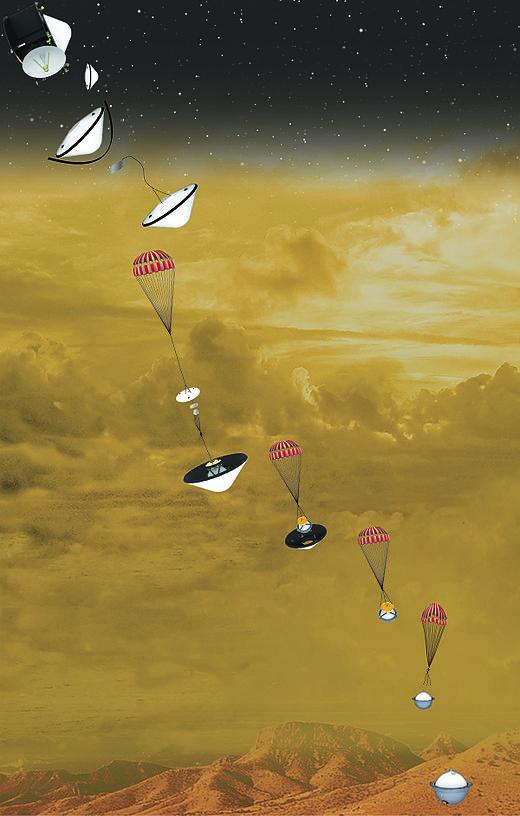
Camera DAVINCI
We often talk about the exploration of Mars, there are a few manned missions to the Red planet. But about Venus for a long time forgotten. The mere fact that a photo with a surface made only by the vehicles of the USSR and only in the 1970-ies, speaks volumes.
Perhaps this will change soon. In November 2016, NASA and Roskosmos have discussed a joint mission to Venus. The planned project is called "Venus D". A prototype for a new satellite within the mission to be the Soviet space station "VEGA-2", its lander in 1985, sat on the surface of Venus.
Colonization Of Venus
What do we know about Venus today? Venus — the second planet from the Sun, and the average temperature is 460 °C, above the melting point of zinc and lead. Most organic materials also unable to maintain good form at this temperature. On Mars, for comparison, the average temperature is 40 °C below zero.
But compared to Mars it makes no sense, because Venus is considered earth-like planet. What are the similarities? First, the radius of Venus is 6051.8 km is 95% of the earth's radius. Mass of 4.87·1024 kg, that is 81.5% of the earth. The acceleration due to gravity is 8.87 m/S2, when our planet it is equal to 9.8 m/S2. Venus has an atmosphere 90 times thicker than Earth. However, for the extremely dangerous and poisonous. And the pressure is as the depth of one kilometer in earth's ocean.
The atmosphere of Venus consists mainly of carbon dioxide. At the height of from 50 about 70 kilometers from the surface we are waiting for another unpleasant surprise — the clouds made of sulfuric acid. From behind the clouds, peeking through which is not possible, and due to the winds and eddies in which they are wrapped, Venus was called "Planet of storms" in the eponymous film by Pavel Klushantsev, 1961. "Morning star" it is called due to the fact that clouds reflect sunlight, making Venus the brightest of the observer from the Earth.
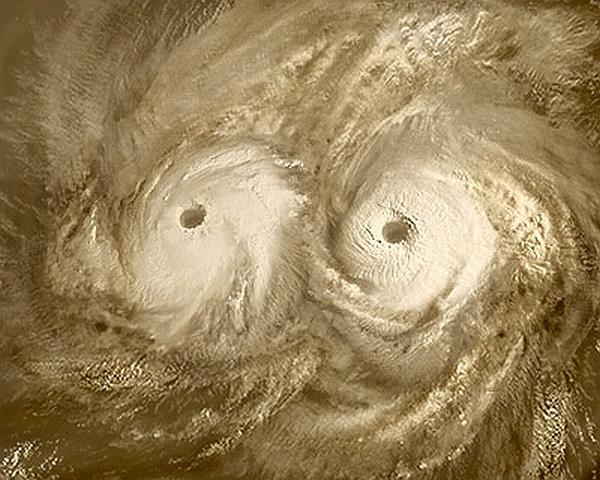
Double hurricane at the pole of Venus, a picture from 2006
The distance from Earth to this planet changes from 38 to 261 million kilometers. Venus may be closer to Earth than Mars is to our planet, away from 55,76 million kilometres. That is, to fly closer to her. So why we want to colonize Mars, and few plans to reach and establish a settlement on Venus?
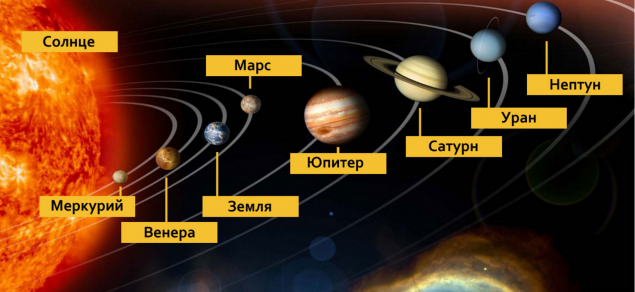
Design engineer Sergey Krasnoselsky, author of the book "a Spare planet", believes that space exploration must necessarily occur. To colonize Venus, you need to it at least to fly. Spacecraft to Venus was launched to the planet's surface planted. Of course, have to solve a lot of questions on the topic of cosmic radiation — one of the main threats to manned flights to other planets. Solar flares provide increased radiation dose to astronauts, but it is possible, for example, to wait in special rooms. Or — create a magnetic field and turn it on when strong solar flares. Issues of flight we have already discussed in the article about the colonization of Mars.
As is clear, the surface of Venus for human life at the moment of little use. But do we need the surface if we can do without solid ground under your feet? Instead, we could use balloons. Due to the composition of the atmosphere the balloon or blimp filled with air, will fly like a helium-filled on Earth. Imagine a beautiful airships hovering at an altitude of 50 kilometers from the surface of a beautiful planet.
Interestingly, people can not live on platforms outside of the balloon, and inside it, to breathe the air and gardening that will support the device at the desired height. This was in September 1971, wrote Sergey Zhitomirsky in the article "Floating home on the morning star" for the journal "technology youth".
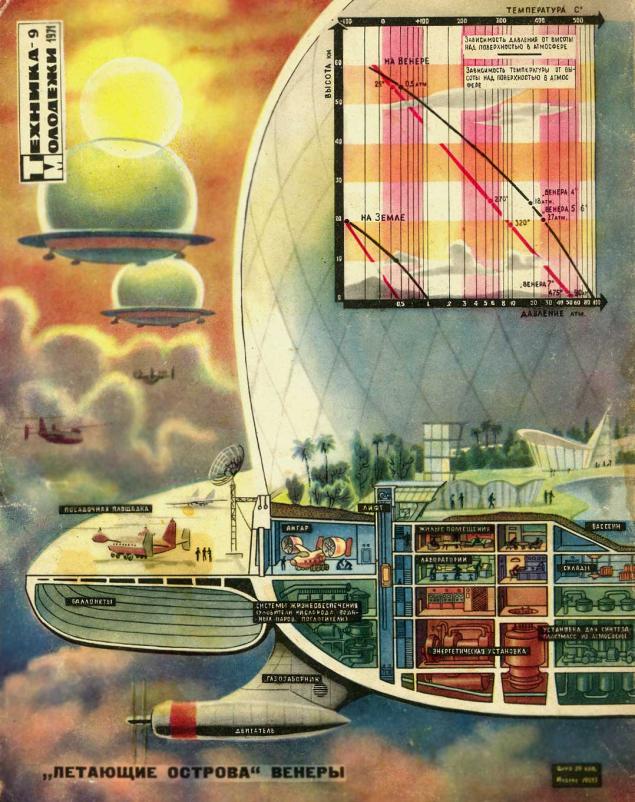
The cover of the magazine "technology of youth", September 1971
NASA in 2014 has proposed to develop Venus before Mars. They presented the project HAVOC. In the framework of the mission, offer to send robots to Venus, then plan a manned mission with a 30 day stay in orbit of the planet, and then another stage with the journey to the upper atmosphere. The orbit will send a robotic airship with a length of 31 meters, and then the ship length 130 meters with astronauts on Board. On top of the proposed devices are located solar cells.
From a psychological point of view, the aircraft will be an important advantage: they can drift and not get into long Venusian night. The days here are equal to 116 earth days and Venus rotates in the opposite direction to the rotation direction of most planets.
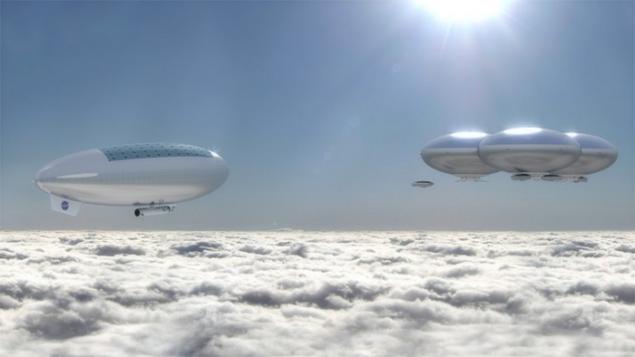
We are talking about an altitude of 50 kilometers, because the temperature is about 75 °C and pressure is one earth atmosphere. Virtually of the earth, except for the composition of the atmosphere. But with the substances of the atmosphere you can work, processing the necessary connections. Due to the proximity to the Sun, lack of energy to work will not occur.
Terraforming
Carbon dioxide, in theory, can be divided into carbon and oxygen, sulphuric acid of sulphur, water and oxygen. But it is better to take the maximum program and to radically change the composition of the atmosphere of the planet.
Venus already has an atmosphere, albeit uninhabitable. Billions of years ago the Earth was also the for us the atmosphere, it has changed microorganisms. Today, many do not need to wait. It is sufficient to select the desired microorganisms and to throw them to the planet. It is very difficult and very expensive, but it is possible.
In 1961, Carl Sagan proposed to use Chlorella. While these single-celled algae offered to use in food and for producing oxygen on Board a space ship. According to Sagan, Chlorella, with no enemies, will begin to multiply rapidly and to recycle carbon dioxide into oxygen. He later abandoned this idea when it became clear that in the atmosphere of Venus is negligible amount of water. Today you need to choose the other microorganisms. Changes in the composition of the atmosphere in favor of oxygen increase will help lower the temperature.
To the idea of Sagan became more real, and generally for creation of acceptable living conditions, on Venus it is necessary to deliver the water. To take her from the Earth in the cylinders would be too expensive. It is much better to find a suitable ice asteroid with a diameter of 600 kilometers and throw it to the planet. NASA a few years considering the idea of capture and delivery of asteroid to the lunar orbit, but there we are talking about the stones up to 10 meters in diameter. In any case, the collapse of one huge asteroid on the planet will lead to disastrous results, so it is better to throw a lot of small. But as soon as the pressure falls and there is enough water — you start microogranism and wait, when Venus will become Earth. This process is similar to the one that billions of years ago happened on our planet. But the time in the case of Land needed is much more, as well as those microorganisms that have formed our atmosphere, themselves at this time evolved.
But then there will be problem — radiation. On Earth from cosmic radiation magnetic field protects us. Venus has no global magnetic field. It can be created artificially. There are two solutions atooi tasks. The first is to spin the planet up to the desired speed of rotation. In theory, by the kernel, presumably of metal, it will create the desired magnetic field. Second — to lay the electrical wire along the equator. It sounds much more realistic, given that even the wire on the bottom of the Atlantic ocean seemed like a fantasy.
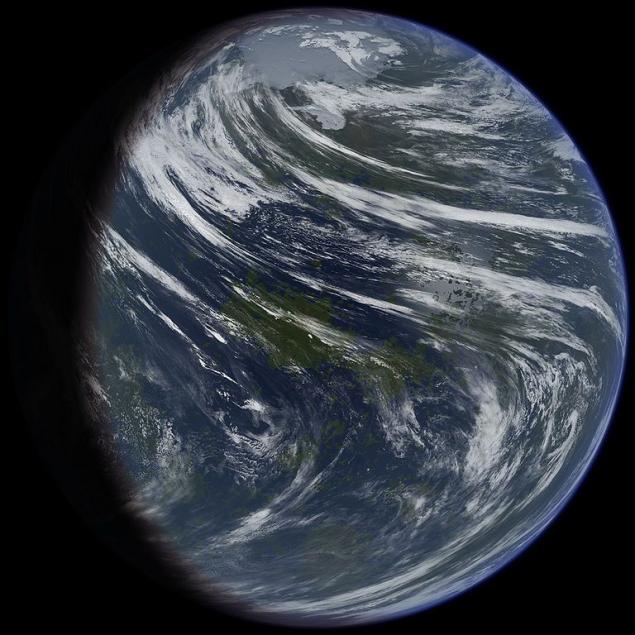
How would look like Venus after terraforming
What's the point?
Why do we need Venus? In the name of science, of course! One of the answers is almost the same as in the case of Mars. Humanity can just sit idly by, continuing to launch astronauts into earth orbit, or to learn at least the Solar system, no technology krisna able to support the crew life for years, decades and even hundreds of years. Venus is the closest planet to us.
Another answer lies in the fact that Venus is similar to Earth. If you create it suitable for human life conditions, we will have, where to go in case our home planet will go a huge asteroid that threatens to wipe out life from the face of the Earth.
Another reason follows from the previous: Venus can move some people from Earth to avoid overpopulation. This planet can become a second home to us.
Sergey Krasnoselsky in an interview for Roskosmos said: "Humanity must move forward. Checked: all civilizations that have fallen into stagnation, they died, they left."
Source: geektimes.ru/post/282546/

The artistic representation of the floating city on Venus
Study Venus
The first soft landing on Venus with the subsequent data transmission to Earth took place in December 1970. Apparatus "Venera-7" was launched from Baikonur on August 17, 1970, in 8 hours 38 minutes Moscow and a few months sat on Venus. And it was the first ever workable landing of a spacecraft on another planet.
As the name implies, it was not the first device. Before him, in 1961 the Soviet scientists launched the "Sputnik 7", which failed to exit from earth orbit. A few days Venus-1 went to the planet and passed at a distance of a hundred thousand miles away from her. A week after the station has stopped responding. Station "Venera-2" in 1965, flew a distance of twenty-four thousand kilometers from Venus, and Venera-3 reached their goal, but are unable to transmit data after landing. But it brought to Venus metal globe of the Earth with a pennant with the emblem of the Soviet Union.
Automatic research space station "Venera-7" was built taking into account a large number of not very successful launches. Previous spacecraft have helped scientists learn the conditions in which you will have to work. The new station had to withstand pressure six times greater than that of the two before her. Body reentry built from titanium to withstand pressures up to 180 atmospheres. For easing landing apparatus equipped with a grooved cone-shaped parachute of the four layers of stalonetray. As the energy carrier used a lead-zinc battery, charged by solar panels.
This device transmitted data to Earth for fifty-three minutes, twenty after landing. Thanks to the apparatus found that the surface temperature is 475 ±20 °C, pressure of 90 ±15 atmospheres. Before we received the first pictures from Mars, Soviet specialists got a picture with Venus. They made apparatuses "Venera-9 and Venera-10". Apparatus "Venera-13" made 14 color images of the planet.
In parallel with Soviet studies of Venus and was engaged in the United States. In 1962 to the "Morning star" launched "Mariner 1" but the booster rocket deviated from course and was blown up. In 1962 it was followed by "Mariner-2", the unit flew past Venus at a distance of 34 773 km. "Mariner-5" 1967 flew even closer, to 3 990 kilometers from the planet's surface. Cameras and cameras, unfortunately, none of the devices had, and all the other "Mariner" flying to Mars.

Photo, "Venus-9" and "Venera-10"

Photo, "Venus-13"
One of the programs on the study of Venus — the DAVINCI mission, which NASA plans for 2021. In the framework of the lander within 63 minutes to collect data about the planet's atmosphere, as well as check the activity of volcanoes and the interaction of the atmosphere with the surface.

Camera DAVINCI
We often talk about the exploration of Mars, there are a few manned missions to the Red planet. But about Venus for a long time forgotten. The mere fact that a photo with a surface made only by the vehicles of the USSR and only in the 1970-ies, speaks volumes.
Perhaps this will change soon. In November 2016, NASA and Roskosmos have discussed a joint mission to Venus. The planned project is called "Venus D". A prototype for a new satellite within the mission to be the Soviet space station "VEGA-2", its lander in 1985, sat on the surface of Venus.
Colonization Of Venus
What do we know about Venus today? Venus — the second planet from the Sun, and the average temperature is 460 °C, above the melting point of zinc and lead. Most organic materials also unable to maintain good form at this temperature. On Mars, for comparison, the average temperature is 40 °C below zero.
But compared to Mars it makes no sense, because Venus is considered earth-like planet. What are the similarities? First, the radius of Venus is 6051.8 km is 95% of the earth's radius. Mass of 4.87·1024 kg, that is 81.5% of the earth. The acceleration due to gravity is 8.87 m/S2, when our planet it is equal to 9.8 m/S2. Venus has an atmosphere 90 times thicker than Earth. However, for the extremely dangerous and poisonous. And the pressure is as the depth of one kilometer in earth's ocean.
The atmosphere of Venus consists mainly of carbon dioxide. At the height of from 50 about 70 kilometers from the surface we are waiting for another unpleasant surprise — the clouds made of sulfuric acid. From behind the clouds, peeking through which is not possible, and due to the winds and eddies in which they are wrapped, Venus was called "Planet of storms" in the eponymous film by Pavel Klushantsev, 1961. "Morning star" it is called due to the fact that clouds reflect sunlight, making Venus the brightest of the observer from the Earth.

Double hurricane at the pole of Venus, a picture from 2006
The distance from Earth to this planet changes from 38 to 261 million kilometers. Venus may be closer to Earth than Mars is to our planet, away from 55,76 million kilometres. That is, to fly closer to her. So why we want to colonize Mars, and few plans to reach and establish a settlement on Venus?

Design engineer Sergey Krasnoselsky, author of the book "a Spare planet", believes that space exploration must necessarily occur. To colonize Venus, you need to it at least to fly. Spacecraft to Venus was launched to the planet's surface planted. Of course, have to solve a lot of questions on the topic of cosmic radiation — one of the main threats to manned flights to other planets. Solar flares provide increased radiation dose to astronauts, but it is possible, for example, to wait in special rooms. Or — create a magnetic field and turn it on when strong solar flares. Issues of flight we have already discussed in the article about the colonization of Mars.
As is clear, the surface of Venus for human life at the moment of little use. But do we need the surface if we can do without solid ground under your feet? Instead, we could use balloons. Due to the composition of the atmosphere the balloon or blimp filled with air, will fly like a helium-filled on Earth. Imagine a beautiful airships hovering at an altitude of 50 kilometers from the surface of a beautiful planet.
Interestingly, people can not live on platforms outside of the balloon, and inside it, to breathe the air and gardening that will support the device at the desired height. This was in September 1971, wrote Sergey Zhitomirsky in the article "Floating home on the morning star" for the journal "technology youth".

The cover of the magazine "technology of youth", September 1971
NASA in 2014 has proposed to develop Venus before Mars. They presented the project HAVOC. In the framework of the mission, offer to send robots to Venus, then plan a manned mission with a 30 day stay in orbit of the planet, and then another stage with the journey to the upper atmosphere. The orbit will send a robotic airship with a length of 31 meters, and then the ship length 130 meters with astronauts on Board. On top of the proposed devices are located solar cells.
From a psychological point of view, the aircraft will be an important advantage: they can drift and not get into long Venusian night. The days here are equal to 116 earth days and Venus rotates in the opposite direction to the rotation direction of most planets.

We are talking about an altitude of 50 kilometers, because the temperature is about 75 °C and pressure is one earth atmosphere. Virtually of the earth, except for the composition of the atmosphere. But with the substances of the atmosphere you can work, processing the necessary connections. Due to the proximity to the Sun, lack of energy to work will not occur.
Terraforming
Carbon dioxide, in theory, can be divided into carbon and oxygen, sulphuric acid of sulphur, water and oxygen. But it is better to take the maximum program and to radically change the composition of the atmosphere of the planet.
Venus already has an atmosphere, albeit uninhabitable. Billions of years ago the Earth was also the for us the atmosphere, it has changed microorganisms. Today, many do not need to wait. It is sufficient to select the desired microorganisms and to throw them to the planet. It is very difficult and very expensive, but it is possible.
In 1961, Carl Sagan proposed to use Chlorella. While these single-celled algae offered to use in food and for producing oxygen on Board a space ship. According to Sagan, Chlorella, with no enemies, will begin to multiply rapidly and to recycle carbon dioxide into oxygen. He later abandoned this idea when it became clear that in the atmosphere of Venus is negligible amount of water. Today you need to choose the other microorganisms. Changes in the composition of the atmosphere in favor of oxygen increase will help lower the temperature.
To the idea of Sagan became more real, and generally for creation of acceptable living conditions, on Venus it is necessary to deliver the water. To take her from the Earth in the cylinders would be too expensive. It is much better to find a suitable ice asteroid with a diameter of 600 kilometers and throw it to the planet. NASA a few years considering the idea of capture and delivery of asteroid to the lunar orbit, but there we are talking about the stones up to 10 meters in diameter. In any case, the collapse of one huge asteroid on the planet will lead to disastrous results, so it is better to throw a lot of small. But as soon as the pressure falls and there is enough water — you start microogranism and wait, when Venus will become Earth. This process is similar to the one that billions of years ago happened on our planet. But the time in the case of Land needed is much more, as well as those microorganisms that have formed our atmosphere, themselves at this time evolved.
But then there will be problem — radiation. On Earth from cosmic radiation magnetic field protects us. Venus has no global magnetic field. It can be created artificially. There are two solutions atooi tasks. The first is to spin the planet up to the desired speed of rotation. In theory, by the kernel, presumably of metal, it will create the desired magnetic field. Second — to lay the electrical wire along the equator. It sounds much more realistic, given that even the wire on the bottom of the Atlantic ocean seemed like a fantasy.

How would look like Venus after terraforming
What's the point?
Why do we need Venus? In the name of science, of course! One of the answers is almost the same as in the case of Mars. Humanity can just sit idly by, continuing to launch astronauts into earth orbit, or to learn at least the Solar system, no technology krisna able to support the crew life for years, decades and even hundreds of years. Venus is the closest planet to us.
Another answer lies in the fact that Venus is similar to Earth. If you create it suitable for human life conditions, we will have, where to go in case our home planet will go a huge asteroid that threatens to wipe out life from the face of the Earth.
Another reason follows from the previous: Venus can move some people from Earth to avoid overpopulation. This planet can become a second home to us.
Sergey Krasnoselsky in an interview for Roskosmos said: "Humanity must move forward. Checked: all civilizations that have fallen into stagnation, they died, they left."
Source: geektimes.ru/post/282546/
The groom is the dwarf was forced to bring a stepladder
Israeli developers were able to teach the AI to defeat a human in Mortal Kombat

